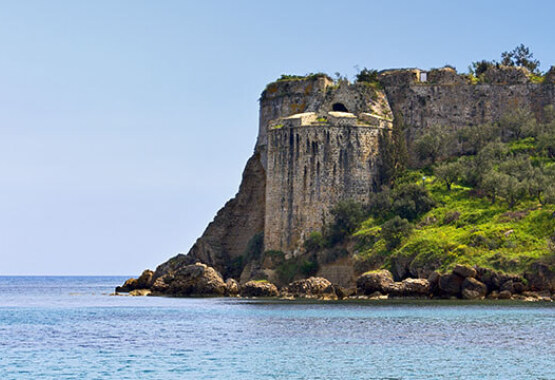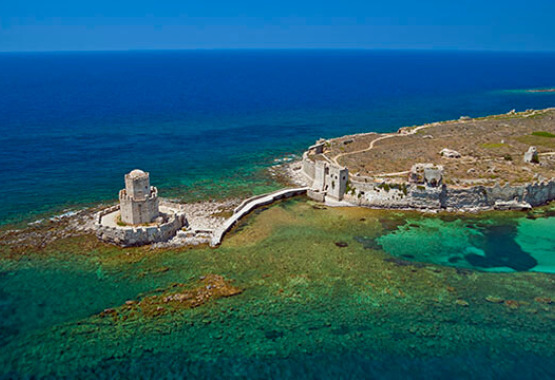
KASTORIA
Dispilio was accidentally discovered when in 1932 the level of Kastoria lake dropped and traces of wooden stakes were revealed. Archaeological excavations were launched immediately in the area, which are considered to this day the most significant that have ever taken place in Greece.
The excavations lasted many years and gradually brought to light invaluable finds dating back to the Neolithic era, including the plaque of Dispilio (5260 BC) around the end of the Middle Neolithic period. Excavations continued systematically at the site revealing more information about a large and structured lake settlement of the Middle and Late Neolithic era. It was not only the oldest found lake settlement found in Europe, but also one of great significance for the continent as well as for Greek archaeology, as it was the first one that was ever unearthed in the country.
Scholars have concluded that the settlement of Dispilo was a highly organized society of around 3,000 people. The findings that have come to light prove that the inhabitants of the settlement made tools and utensils from everyday materials found in nature, bred animals, developed their own writing system and created an early form of music. They fished to cover their basic feeding needs and had found various ways to store food. The houses were either built in a circular or in a rectangular shape while some were placed in the lake, resting on stakes that protected them from water.
Visitors to the site, which is eight km from the city of Kastoria, are given a glimpse into life during prehistoric times at the archaeological park, which is a faithful reconstruction of Dispilio, as it was in the Middle Neolithic Period. The design of the reconstructed settlement, and the dimensions of its eight life-size huts are based entirely on results of archaeological studies and findings in the area over the decades. The huts are made of tree trunks, branches and rope, while lake mud was used to make the plaster of each house. The roofs are covered with straw.
To take a glimpse into the life of Dispilo’s prehistoric people, several copies of the finds unearthed during the excavations were placed in the huts. These include some tools made from flint, everyday objects such as pots, plates and cups made of clay, as well as animal bones.
The museum in the village displays all the finds that have been dug up. Many of them provide insights as to how sophisticated the lives of Dispilo’s residents were. For example, a flute made of bones bears witness to the existence of early music. Among the most significant items discovered is the inscription of Dispilio, which reveals, beyond any doubt, the existence of an original form of written speech.
The settlement and the museum can be visited daily from 9:00 am to 7 pm (including holidays). Organized guided tours are also available.
Dispilio of Kastoria
The oldest Neolithic settlement in Europe
The settlement of Dispilo, officially the oldest Neolithic settlement in Europe, is located 8km from the town of Kastoria (on the road Kastoria - Argos Orestiko).Dispilio was accidentally discovered when in 1932 the level of Kastoria lake dropped and traces of wooden stakes were revealed. Archaeological excavations were launched immediately in the area, which are considered to this day the most significant that have ever taken place in Greece.
The excavations lasted many years and gradually brought to light invaluable finds dating back to the Neolithic era, including the plaque of Dispilio (5260 BC) around the end of the Middle Neolithic period. Excavations continued systematically at the site revealing more information about a large and structured lake settlement of the Middle and Late Neolithic era. It was not only the oldest found lake settlement found in Europe, but also one of great significance for the continent as well as for Greek archaeology, as it was the first one that was ever unearthed in the country.
Scholars have concluded that the settlement of Dispilo was a highly organized society of around 3,000 people. The findings that have come to light prove that the inhabitants of the settlement made tools and utensils from everyday materials found in nature, bred animals, developed their own writing system and created an early form of music. They fished to cover their basic feeding needs and had found various ways to store food. The houses were either built in a circular or in a rectangular shape while some were placed in the lake, resting on stakes that protected them from water.
Visitors to the site, which is eight km from the city of Kastoria, are given a glimpse into life during prehistoric times at the archaeological park, which is a faithful reconstruction of Dispilio, as it was in the Middle Neolithic Period. The design of the reconstructed settlement, and the dimensions of its eight life-size huts are based entirely on results of archaeological studies and findings in the area over the decades. The huts are made of tree trunks, branches and rope, while lake mud was used to make the plaster of each house. The roofs are covered with straw.
To take a glimpse into the life of Dispilo’s prehistoric people, several copies of the finds unearthed during the excavations were placed in the huts. These include some tools made from flint, everyday objects such as pots, plates and cups made of clay, as well as animal bones.
The museum in the village displays all the finds that have been dug up. Many of them provide insights as to how sophisticated the lives of Dispilo’s residents were. For example, a flute made of bones bears witness to the existence of early music. Among the most significant items discovered is the inscription of Dispilio, which reveals, beyond any doubt, the existence of an original form of written speech.
The settlement and the museum can be visited daily from 9:00 am to 7 pm (including holidays). Organized guided tours are also available.




